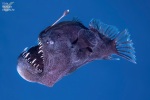Discover the reason for the longevity of the shark that lives up to 500 years
Discover the shark that lives up to 500 years. Scientists reveal its secret to resisting aging. A wonder of nature!...
Table of Contents
- The Longevity of the Greenland Shark
- Unique Adaptations to an Extreme Environment
- Late Reproduction and Hunting Strategies
- Scientific Implications and Biological Mysteries
Follow Patricia Alegsa on Pinterest!
The Longevity of the Greenland Shark
In the deep and icy waters of the Arctic, there resides a creature whose longevity defies scientific understanding: the Greenland shark (Somniosus microcephalus).
This species, capable of living for several centuries, has become an object of fascination for marine biologists and aging researchers.
With a lifespan that can reach 500 years, some Greenland sharks are older than many modern countries.
The lifespan of the Greenland shark is astonishing. While most marine and terrestrial creatures have a relatively short life, these sharks can live at least 270 years, and some approach 500 years.
The lifespan of the Greenland shark is astonishing. While most marine and terrestrial creatures have a relatively short life, these sharks can live at least 270 years, and some approach 500 years.
This fact makes them the longest-lived vertebrates known on the planet, raising intriguing questions about the biological mechanisms that allow for such longevity.
The key to their longevity lies in their unique metabolism. Unlike what happens in most animals, the metabolism of Greenland sharks does not significantly slow down with age, which prevents the typical cellular changes of aging.
Unique Adaptations to an Extreme Environment
The key to their longevity lies in their unique metabolism. Unlike what happens in most animals, the metabolism of Greenland sharks does not significantly slow down with age, which prevents the typical cellular changes of aging.
Researchers like Ewan Camplisson, a biologist at the University of Manchester, have dedicated their studies to understanding these processes and have presented these surprising findings at international scientific conferences.
The Greenland shark is the only species of shark that can live in the cold Arctic waters year-round. Unlike other species that migrate to avoid low temperatures, these sharks are perfectly adapted to thrive in an environment where temperatures can be extremely low.
The Greenland shark is the only species of shark that can live in the cold Arctic waters year-round. Unlike other species that migrate to avoid low temperatures, these sharks are perfectly adapted to thrive in an environment where temperatures can be extremely low.
Their ability to swim slowly is another remarkable aspect. Although they measure between 6 and 7 meters long, they are one of the slowest swimming fish in relation to their size, allowing them to conserve energy in an environment where food resources are limited.
One of the most intriguing characteristics of the Greenland shark is its extremely late reproduction. Females do not reach sexual maturity until approximately 150 years, an unprecedented fact in the animal kingdom.
Late Reproduction and Hunting Strategies
One of the most intriguing characteristics of the Greenland shark is its extremely late reproduction. Females do not reach sexual maturity until approximately 150 years, an unprecedented fact in the animal kingdom.
This delay in reproduction is likely an adaptation to their environment, where mating opportunities may be scarce and growth is slow due to low temperatures and limited food availability.
Despite having tiny brains, Greenland sharks are capable of hunting and navigating great distances. This suggests that they possess advanced cognitive abilities that are still not fully understood.
Despite having tiny brains, Greenland sharks are capable of hunting and navigating great distances. This suggests that they possess advanced cognitive abilities that are still not fully understood.
The majority of the population of these sharks lives much of their life with parasites in their eyes, indicating that they rely more on other senses, such as smell, to hunt and move around.
The flesh of the Greenland shark is highly toxic to humans due to the presence of compounds such as urea and trimethylamine oxide (TMAO). These compounds not only help sharks survive in the cold Arctic waters by stabilizing their proteins, but they also make them practically invulnerable to human predation. However, this toxicity does not seem to affect their own health, which adds another layer of mystery to their unique biology.
The sum of these characteristics makes these creatures a singular species, extraordinarily adapted to their environment and capable of living a long and seemingly healthy life in conditions that would be extreme for most other living beings.
Scientific Implications and Biological Mysteries
The flesh of the Greenland shark is highly toxic to humans due to the presence of compounds such as urea and trimethylamine oxide (TMAO). These compounds not only help sharks survive in the cold Arctic waters by stabilizing their proteins, but they also make them practically invulnerable to human predation. However, this toxicity does not seem to affect their own health, which adds another layer of mystery to their unique biology.
The sum of these characteristics makes these creatures a singular species, extraordinarily adapted to their environment and capable of living a long and seemingly healthy life in conditions that would be extreme for most other living beings.
In this way, the discoveries about the longevity of the Greenland shark have sparked great interest in the scientific community, not only for their impact on marine biology but also for their potential implications in understanding human aging.
Studies on these sharks may offer valuable clues for developing new strategies against aging and age-related diseases.
Subscribe to the free weekly horoscope
Aquarius Aries Cancer Capricorn Gemini Leo Libra Pisces Sagittarius Scorpio Taurus Virgo
I am Patricia Alegsa
I have been writing horoscope and self-help articles professionally for over 20 years.
Subscribe to the free weekly horoscope
Receive weekly in your email the horoscope and our new articles on love, family, work, dreams and more news. We do NOT send spam.
Astral and numerological analysis
-
 Discover your future, secret personality traits and how to improve in love, business and life in general
Discover your future, secret personality traits and how to improve in love, business and life in general
-
 Online Dream Interpreter: with artificial intelligence
Do you want to know what a dream you had means? Discover the power of understanding your dreams with our advanced online dream interpreter using artificial intelligence that responds to you in seconds.
Online Dream Interpreter: with artificial intelligence
Do you want to know what a dream you had means? Discover the power of understanding your dreams with our advanced online dream interpreter using artificial intelligence that responds to you in seconds.

















